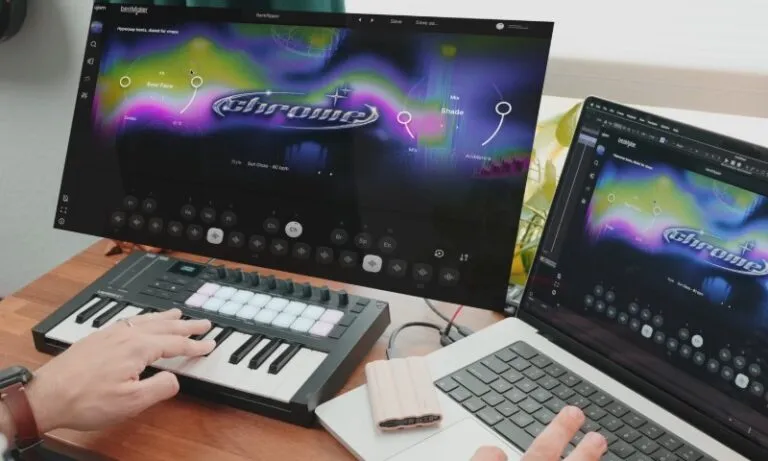Granular synthesis breaks sound into tiny pieces called grains and rearranges them to create new sonic textures.
Each grain lasts just milliseconds, yet when combined, they open vast creative possibilities. Often used in electronic and experimental music, this technique adds depth and unpredictability to productions.
Producers can expect to learn how granular synthesis works, which tools offer the best control, and how to apply these techniques in experimental sound design.
Table of Contents
ToggleWhat is Granular Synthesis and How Does it Work?

Granular synthesis is a sound design technique that breaks audio into tiny segments called grains, which are then reshaped, layered, and played back to create new textures, rhythms, or effects.
It begins by slicing an audio file into tiny fragments known as grains. Each grain typically ranges from a few milliseconds to around 100 milliseconds.
These grains can then be layered, stretched, shifted, and re-pitched for radically altered sounds, guitar sound, for example.
The grain manipulation parameters are:
| Parameter | Description |
|---|---|
| Size | Determines the length of each grain. |
| Density / Count | Controls how many grains are played per second. |
| Pitch | Alters the grain’s frequency, enabling melodic shifts or detuning. |
| Shape | Sets the envelope of each grain, how it fades in and out, affecting smoothness or harshness. |
| Position / Offset | Moves the playhead through the sample to select the granulated section. |
| Jitter / Randomness | Introduces unpredictability in grain behavior, adding glitchy or chaotic qualities. |
| Stretch / Speed / Retrigger | Found in FX-style processors; manipulates timing, repetition, and motion drastically. |
Playback Techniques:
- Static Grain Looping: Repeats a set group of grains for a stable tone.
- Moving Playhead: Continuously scans across the sample to keep the texture evolving.
- Live Input vs. Pre-recorded Samples: Real-time processing enables spontaneous creativity, while static samples offer more control.
Granular synthesis provides unmatched flexibility in sculpting sound through micro-level control.
Tools and Platforms for Granular Synthesis

Granular synthesis has found its place in many production environments, made possible by a wide range of tools that cater to different creative workflows.
Some producers prefer plugin-based solutions for their flexibility inside a DAW, while others rely on hardware for a tactile and focused experience.
Many modern DAWs also include built-in granular effects or support third-party plugins, making it easy to experiment without leaving the software environment.
Software Plugins
Several plugins provide refined control over grain manipulation, each offering specialized features. Here are a few standout options:
| Tool / Device | Type | Key Features | Best For |
|---|---|---|---|
| Portal by Output | Software Plugin | Real-time modulation, intuitive interface, drag-and-drop workflow, built-in presets | Rhythmic glitch patterns, granular delays, ambient textures |
| STRAYLIGHT by Native Instruments | Software Plugin | Granular synthesis + sample playback, effects layering, curated sound library | Cinematic tones, atmospheric sound design, film/game scoring |
| Max/MSP Granulator II | Software Plugin (Max for Live) | Highly modular, customizable grain behavior, deep integration with Ableton Live | Experimental tweaking, academic sound research, Ableton-based setups |
| Hardware Options (General) | Hardware Synths | Standalone grain processing, hands-on physical control | Studio or live performance without computer dependency |
| Tasty Chips GR-1 | Hardware Synth | Touchscreen interface, MIDI compatibility, USB sample loading, physical controls | Live shows, resampling, standalone granular experimentation |
Creative Applications in Sound Design
Granular synthesis isn’t just technical, it’s expressive. It breaks sonic expectations and pushes production boundaries. By manipulating micro-fragments of audio, producers can reshape texture, time, and tonality in radical ways.
Each creative path offers unique sonic rewards, especially when specific applications are examined in detail.
Ambient Textures
Simple recordings, wind, water, fabric rustling, or human breath, become lush ambient backdrops. Granular synthesis excels at building slow-moving, immersive drones.
By looping and stretching grains, sound turns into atmosphere. Adjusting grain size and density adds subtle motion and complexity.
Key techniques used to generate ambient textures include:
- Extremely short grain size: Provides smooth, smeared textures.
- Slow playhead movement: Maintains cohesion and a sense of flow.
- Low grain density: Prevents over-cluttering and keeps textures breathable.
- Random pitch modulation: Introduces subtle fluctuations without tonal harshness.
Perfect for scoring emotional cues, creating soundbeds for installations, or enhancing meditative tracks.
Glitch and Experimental Effects
Granular synthesis also thrives in chaos. Intentional disruption of time, pitch, and grain placement leads to disjointed, glitchy effects.
Sudden bursts of grains can stutter, splatter, or bend sound in unexpected ways.
Producers looking for controlled chaos can apply:
- High jitter settings: Adds randomness in timing and pitch.
- Short grain windows with sharp envelopes: Introduces percussive clicks or rasps.
- Rapid retriggering and automation: Causes spasmodic, electronic textures.
- Random grain position scanning: Produces broken speech, data corruption-style effects.
Effective in avant-garde music, cyberpunk scores, or transitions meant to jar or surprise.
Evolving Pads
Pads gain new life with grain manipulation. Instead of static chords, pads can pulse, drift, and shimmer.
By combining automation and modulation sources like LFOs, each note evolves across time.
Popular methods for pad transformation include:
- LFO-driven pitch and position modulations: Adds movement without losing musicality.
- Variable grain size: Offers smooth transitions between textural states.
- Layered grain outputs: Builds a fuller stereo image with tonal spread.
- Automated filtering or reverb post-processing: Further enhances dreamlike qualities.
Used frequently in ambient, cinematic, and chillout genres where depth and motion matter more than rhythmic drive.
Melodic and Harmonic Manipulation
Granular synthesis allows for tuning grains independently, stacking them to form new harmonies. Instead of relying on traditional note input, producers generate tonal content by warping audio fragments.
Creative approaches for melody construction include:
- Pitch quantization of grains: Converts textures into playable instruments.
- Time-stretched melodic samples: Produces haunting or surreal results.
- Layering grains with harmonic intervals: Creates synthetic chord progressions.
- Grain-by-grain pitch shifting: Useful for experimental vocal processing or digital choirs.
This method works especially well in experimental pop, electronic hybrids, and sound design for games.
Live Audio Processing

Granular synthesis doesn’t have to rely on static samples.
Feeding live input into granular engines enables performers to manipulate real-time audio, ideal for improvisation or dynamic effects during live sets.
Practical applications for real-time use involve:
- Granular delay effects on vocals or instruments: Introduces echoes and spatial artifacts.
- Automated grain scanning: Adapts automatically to changes in pitch or rhythm.
- Envelope-following modulation: Responds to performance intensity in real-time.
- MIDI or gesture-controlled grain parameters: Offers expressive live manipulation.
Useful for vocalists, modular artists, or anyone building interactive performances.
Summary
Granular synthesis offers more than a toolset, it opens paths to sonic experimentation that defy traditional structures. Tiny fragments of sound become a canvas for imagination, chaos, and control.
Producers ready to explore should try plugins like Portal or Granulator II, dive into hardware like the GR-1, or use built-in DAW tools to start manipulating grains.
Studying artists who champion granular techniques, like Alva Noto, Tim Hecker, or Holly Herndon, can provide inspiration and insight. Start small, tweak parameters, and let textures unfold.












